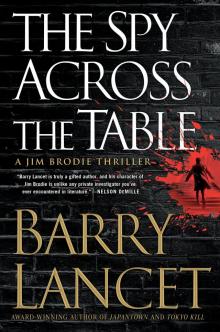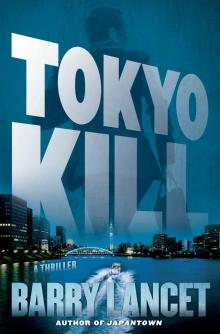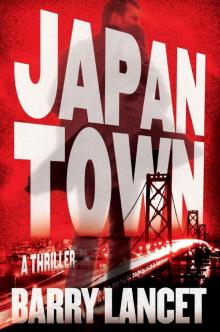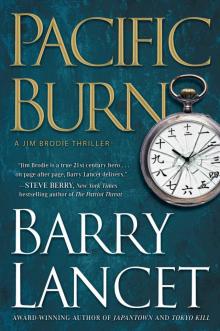- Home
- Barry Lancet
The Spy Across the Table Page 2
The Spy Across the Table Read online
Page 2
Law enforcement was in the process of sealing off the theater.
No one was getting in or out.
I clung to the shadows and scanned the crowd in the wings, wondering if the assassin had managed to infiltrate the group of observers. I’d seen him in profile. Most of the onlookers were from the Japanese crew. Of the remaining men, some had darker skin than the shooter. Others were too tall, or too short, or too wide.
My target wasn’t among them.
Which meant he’d turned off earlier and I’d missed the turn.
I reviewed the layout from the freight entrance forward. There had been the maze of dressing rooms, a big lumpy circle of an affair. Then, fronting them, two rows of permanent dressing rooms, followed by three rows of industrial steel shelving six feet high and stocked with every kind of theatrical accoutrement. Next, perpendicular to the shelving, was a long row of freestanding painted sets, lined up like billboards, about five feet apart and propped in place by long, footed dowels of wood. And last, just before the drop curtain at the rear of the stage, was a ragged line of A-frame trolleys with Kabuki backdrops on each side of the A.
There were aisles between each grouping.
The killer must have turned down one of them.
From where I stood, I could look down the aisle between the A-frames and the freestanding backdrops. My target wasn’t there. At the end of the row, beyond the line of painted sets, the muted green glow of an exit sign announced its presence.
That had to be his next destination.
There was no other outlet in sight.
I scrambled back the way I’d come, the theater wall to my left, the first of the thirty-foot-long painted backdrops to my right. I peered down the aisle between the backdrops and the first row of shelving. Halfway down, a figure retreated into the darkness.
Found you, you bastard.
The gunman was inching along with extreme caution. He wanted to avoid running into staff or security. Which told me he lacked a crew badge or a backstage pass to let him past the checkpoints in the wings and elsewhere without attracting attention.
I could still catch him.
I slipped off my black tennis shoes, hustled back toward the first aisle, then charged down it as fast as I could without making any noise. At the halfway point I lobbed both shoes high above my head, one after the other. Long, looping hook shots. The footwear rose above the tops of the sets, then clattered down between them. The disturbance would not draw the attention of the police in the wings but would give the attacker pause—and me the time I needed to push on ahead of him and circle back.
Shoeless, I sprinted to the end of the backdrops, paused, and took a flash-peek around the corner. The area was bathed in the pear-green aura of the exit sign, but I spied no trace of the gunman. Large red lettering on the door jumped out at me:
FOR EMERGENCIES ONLY.
ALARM WILL ACTIVATE.
I smiled. The killer’s options were shrinking. He couldn’t risk exiting this way. The alarm would alert any badges in the public corridors on the other side and they would rush his way to double-check his credentials.
I tore across the length of the backdrop and positioned myself at the far end, out of sight but between the shooter and the exit.
Then I cocked an ear to the silence and waited.
The stage set towered overhead, tall and imposing. Painted canvas was stretched across a framed crosshatch of two-by-fours. I stood alongside an ancient Roman patio with a colonnade. In the center was a marble table overflowing with roasted meats and wines and pyramids of fruit stacked on large silver platters. A feast scene. The brushwork was precise and convincing. In places where walls or buildings needed to look aged or crumbling, the detailing was impressive.
I heard the familiar compression of my target’s footwear.
One step. A slight pause. Another step. Wary and guarded.
Three beats later a gun barrel with a suppressor poked its nose beyond the edge of the backdrop. A hand wrapped around the grip appeared next. I smothered the hand in both of mine and slammed the wrist against the sharp corner of the stage set. I heard a muffled cry. The shooter yanked his arm free and the firearm flew from his grasp and clattered away into the darkness.
I rounded the corner and advanced. The gunman backtracked with unexpected speed. I lunged. He shifted sideways and my momentum carried me past him. He unleashed a blistering blow to my kidney. An electric jolt launched up my spine.
Shaking off the pain, I turned—only to meet a looping right. I managed to deflect the incoming punch with my right forearm and lash out with a left fore-knuckle strike to the throat. But the impact of the blocked punch had knocked me off-center and my shot smacked ineffectually against his chest.
He dove and brought me down with an expert tackle. We both went sprawling across the floor, him on top. Rising and scissoring my ribs between his knees, he began swinging away. I jammed the heel of my left palm into the underside of his chin, then swung my right arm into the side of his torso with the force of a home-run batter taking his best swing. I heard his teeth crunch and the shooter toppled off me.
I rolled away and clambered to my feet. The assassin came up a moment later, favoring his side. As he rose, I aimed a strike at his solar plexus. A direct hit would immobilize him, but my shot crashed into the undamaged side of his rib cage, which did neither of us any good. However, the force of the blow flung him into a cluster of unclothed mannequins, which pitched over like jumbo bowling pins. He went with them.
He scrambled away on his knees, seemingly retreating in a panic. I lost sight of the upper half of his body in the gloom. I advanced. Then I heard metal scraping concrete. Gunmetal.
He hadn’t panicked or retreated.
He’d gone for the weapon.
CHAPTER 5
WITH no chance of reaching the gun ahead of him, or of preventing him from retrieving the firearm, I dove between the two closest stage sets.
I threaded my way through the narrow lane they formed, avoiding the long dowels that propped them in place. I needed to reach the far side and round the corner before the assassin could recover his piece, make it to the mouth of my Roman-style alleyway, and bury a bullet in my back.
Four yards had separated us at the edge of the passage. Sanctuary was ten yards ahead. I’d covered two and counting. Could I reach the end before he drew down on me?
Turned out it didn’t matter: he had a better idea.
Gauging my pace, acceleration, and angle of retreat, he fired blind. A round punched through the scenery five inches behind me. A second bullet followed two feet on and an inch closer.
I kept running.
The deeper I penetrated, the less chance he had of a clean shot. He was blasting through maybe three backdrops to get to my “alleyway.” The odds his bullets would hit crossbeams would rise as the distance between us increased. Clearly, he’d know that too. A third shot didn’t follow. But I heard him scuttling toward the mouth of the passage. Stealth was no longer a priority.
He had four yards, maybe less. I had six. I was picking up speed but the odds weren’t promising. Fifty-fifty, maybe less.
I glanced back. He wasn’t there. My goal loomed five yards on, plus the turn.
Four . . . three . . . I snatched a second backward glance. I saw the silhouette of an approaching figure, gun arm rising. I flung myself to the floor. I heard a shot, then felt a trailing breeze as the round whipped by overhead. I slid across the floor on my belly, my momentum carrying me beyond the end of the lane. I rolled to the right, out of the line of fire, and bounded up and ran.
My breathing was loud and dissonant in my ears. I heard the assassin’s feet pounding down the aisle on the other side of the stage sets. Our roles had been reversed. He was stalking me as I’d stalked him. I looked down the “spokes” of the lanes between sets and caught a glimpse of him. He was a step and a half behind. He fired between the upright backdrops, just inches behind me. Once, twice, three times in succession
. Pop-pop-pop. The same partially muffled sound. Not fully suppressed, which was why the sound carried to the wings. He knowingly used a damaged silencer, no doubt preferring partial suppression to none at all.
I veered left, slipped behind an A-frame, dropped to the ground, and snaked under the large backstage curtain. To the left and right were racks of scenery ready to be whisked onstage. In the cavernous space overhead, I could make out the shadows of ropes and pulleys and catwalks weaving between girders.
Twenty yards away a commanding voice called for additional support: “New gunfire backstage. Where’s our backup? Repeat, more shots fired backstage. We need backup now.”
The salvo had triggered fresh alarm but no one was venturing into the dim backstage arena until more manpower arrived.
I was on my own.
I listened for the shooter but heard nothing.
I peered between the wheels of the closest A-frame and saw nothing.
After another moment I slipped from my hiding place and continued across the theater, using the string of A-frames as cover. Before I reached the police perimeter, I slid over to the other side of the A-frames, then crossed the aisle and ran silently back toward the front end of the row of standing scenery. I crouched down behind the end piece and tuned an ear to any sound.
More nothing.
The killer was still about. He hadn’t risked the exit. He’d continue roaming about the backstage area, looking for another way out.
Which meant I might get another crack at him.
If I could find him before he found me.
The assassin’s options were fast disappearing. More cops would be flooding into the Kennedy Center and its catacomb of corridors and byways. After the second round of shooting, they would be on even higher alert. All public escape routes were either sealed or in the process of being sealed.
Which made the killer more desperate and doubly dangerous.
I grew attentive to the whisper of his shoes—or any sound at all. I detected movement at the rear end of the backdrops, back near the emergency exit.
That couldn’t be. It was suicidal for him to go out that way now.
Then a series of noises erupted. Loud and inexplicable. I heard the protesting creak of lumber, followed by what sounded like twigs cracking, then a loud slap. After a pause, the sequence repeated. A shade faster. Creak-crack-crack-crack-slap. There was another pause before the sequence began again.
It wasn’t a man-made noise, and it wasn’t the assassin coming for me.
The pattern replayed with increasing rapidity. It grew fuller and louder. The floor beneath my feet trembled. The din rose into the rafters. The sounds echoed. They were repeated and amplified and suddenly coming at me from every direction.
I felt the need to move but had no idea which way. I inched toward the center of the backdrop I sheltered behind. From the middle I could go either way. But which way was that?
From my crouching position, I pivoted quietly on my heels and scanned the area in front of me. I took in the shadowy forms of Roman costumes on racks against the wall. Took in a jumble of electrical equipment and wires on a table alongside the costumes. I shot long looks to the extreme left, then the extreme right. Nothing stirred. There was no sign of the killer. No cops approached from the wings.
Behind me, the clamor grew louder. The vibrations underfoot grew more energetic. I stood, hoping for a better view. The new perspective didn’t help. The set towered fourteen feet above my head and an equal number of feet in each direction.
Which way to go? From which side might the shooter come? Left or right?
By the time I figured out the answer—neither—it was too late.
The oversize canvas behind me shuddered and groaned and tilted toward me. One of the three-foot dowels propping it up snapped like a twig. Another followed. The cracking sound. Others bent to their limit, then popped loose and somersaulted into the air.
I started to back away.
The backdrop, twisting and straining, broke free of its mooring and toppled forward.
In a flash I understood. The assassin had rocked the set on the far end back and forth, pressuring the moorings until they gave way. The first billboard-size backdrop broke free and fell against the next one in line with a loud slap. The scenery began to fall—ponderously at first, then faster—like giant dominos.
Now the last domino had capitulated and, with the combined weight of three or four of its closest brethren, threatened to crush me. At both sides, the space began to narrow. The 90-degree angle of the upright backdrop rapidly became 80, then 70 degrees.
I didn’t wait. I turned and fled. Two steps later three hundred pounds of painted stage scenery slammed into me. My deltoids absorbed the brunt of the blow. The force dropped me to my knees and shoved me forward. I slid over the slick blue cement surface. The canvas slammed into me again.
The weight settled on my shoulders and pressed relentlessly down.
I pushed back. My momentum slowed, then stalled. The set creaked and moaned and forced me lower. The weight became cumbersome, then unbearable. I tried to inch forward but it was all I could do to hold my position.
My legs gave out and I found myself facedown, trapped under the insistent weight. My head and shoulders had escaped, but the rest of my body was pinned to the floor. My breathing grew labored. I took shallow breaths. Dizziness swooped in.
Then the power died and the backstage lighting went out. Shouts of confusion echoed through the darkness. I could feel the air being squeezed from my lungs. I tried to call out but only a ghostly rattle emerged.
A second before consciousness deserted me, the signature exhale of the assassin’s footwear approached. A pair of shoes stopped inches from my face. The shooter reached down and plucked my backstage pass from around my neck. Helplessly, I watched the strap and plastic ID holder levitate and disappear into the blackness above.
The killer had found his exit strategy.
CHAPTER 6
A SHORT time later, the pressure eased.
I opened my eyes.
I tried to speak but the words wouldn’t come. My breathing was shallow, my air intake inadequate. When I tried to rise, I found myself still pinned to the floor. The pressure was heaviest against my calves. My left cheek rested on the cool blue cement. A vague throbbing pulsed across my upper back.
Oversize wheel stops had been wedged under the Roman-themed backdrops to lift some of the weight off me.
I’d come close to suffocating but breathed a little easier now. Images of Mikey and Sharon bleeding out in the back dressing room flooded my thoughts. What had happened in the short time I’d been out? Had the doctor and the paramedics been able to revive my friends? And what about the killer? Had they grabbed him?
My line of sight ran along the floor, about ankle height. Three pairs of footwear formed a neat semicircle five feet away: tactical boots, polished oxfords, pink canvas sneakers.
I craned my neck and matched the shoes to faces. But not before I found myself staring up into the barrels of two guns staring right back down. One rested in the palm of the sharp-nosed Secret Service agent. The owner of the oxfords. The other belonged to a local cop, who had a large squat face, two chins, and an upturned nose over the powder-blue shirt of the metropolitan police department. The owner of the boots.
“Your name?” the Secret Service agent said.
Raspy and low, a voice emerged this time. “Jim Brodie. Are the victims okay?”
“We’ll get to that.”
“Did anyone catch the shooter?”
“Looks to me like we nailed him just fine,” the DC badge said.
The canvas shoes shuffled uneasily. They sheathed the feet of a blond-haired woman in beige cargo pants and a sleeveless gray sweatshirt. A stagehand. Maybe a manager. She tapped a clipboard lightly against her thigh. On hearing my name she raised the board and began flipping through a collection of papers. A leather tool belt with screwdrivers and pincers and clamps circled her hips
.
I caught the Secret Service agent’s attention. “You saw me in the wings. I was there when the shots were fired.”
The local badge sneered. “Don’t mean you ain’t an accomplice.”
“Don’t mean you don’t have spaghetti for brains either,” I said.
The stagehand stopped flipping pages. “His name’s on the list for backstage passes. Courtesy of Sharon Tanaka. Came in together with a Michael C. Dillman.”
The metro cop’s eyes gleamed. “Gotcha,” he said.
“They’re both friends,” I said.
“Even better.”
With the barrel of his gun trained on my head, he squatted down inches from my face, unhitched a pair of handcuffs from his belt with his free hand, and said, “Lookee, lookee. Your one-way ticket to hell.”
* * *
Two members of the stage crew arrived with a long crowbar, a thick wooden block, and an abject apology.
“We’re sorry,” one of them said. “With all the extra backdrops for the Japanese plays, we ran short of A-frame racks for the Roman scenery of the next event. This isn’t the first time the unsecured sets have toppled over, but the restraints have always been sturdy enough to prevent a chain reaction.”
“Unless they were given some additional help,” I said.
The Secret Service agent frowned. “What do you mean?”
“I chased the killer from the cargo bay. I caught up with him, then lost him. I was looking to jump him again but he outfoxed me the second time. He shoved the first couple of backdrops until they built up a natural momentum. Probably helped them along to keep them going.”
“So where do you think he went?” the agent asked. “The whole complex is sealed off.”
“If he’s not here, he slipped out during the commotion. On a stolen pass.”
“Whose?”
“Mine.”
The local badge grinned up at the taller agent. “Just like I said. This guy’s an accomplice.”

 The Spy Across the Table
The Spy Across the Table Tokyo Kill
Tokyo Kill Japantown
Japantown Pacific Burn
Pacific Burn